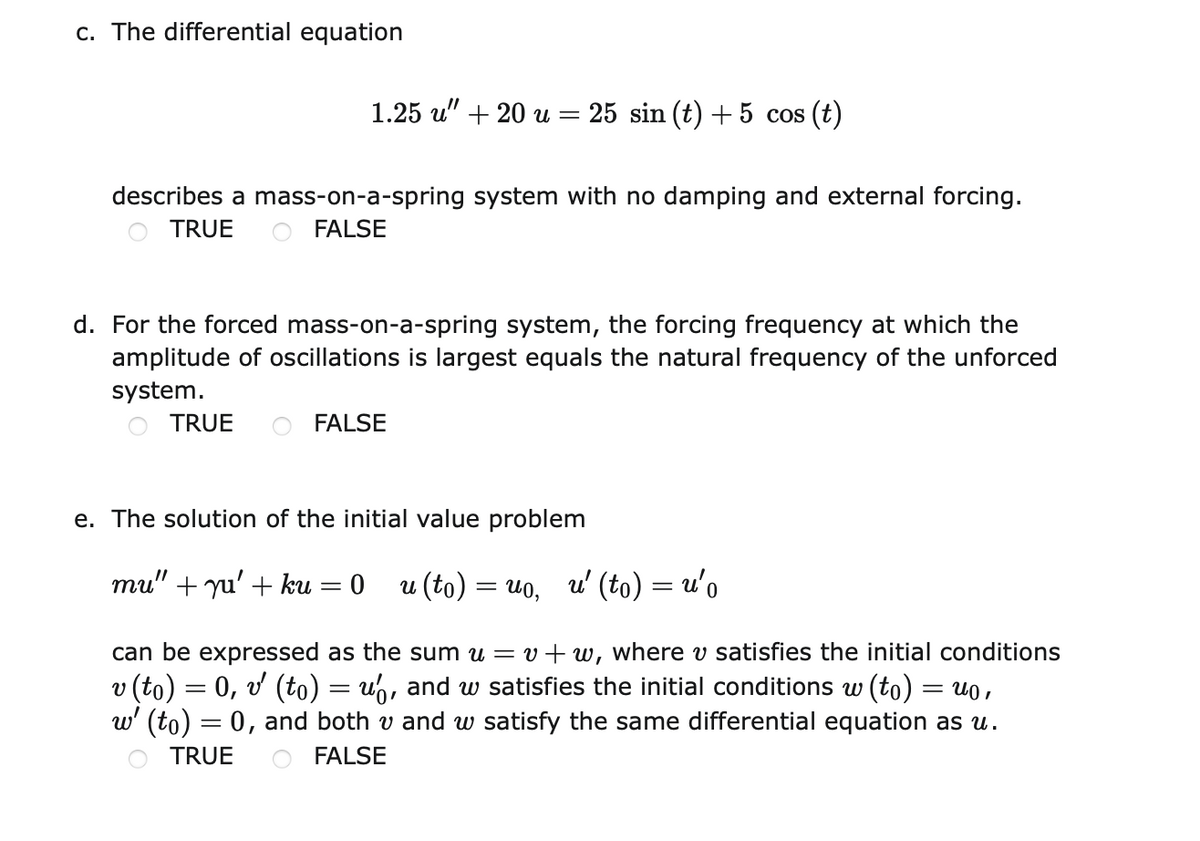c. The differential equation 1.25 u" + 20 u = 25 sin (t) +5 cos (t) describes a mass-on-a-spring system with no damping and external forcing. O TRUE O FALSE d. For the forced mass-on-a-spring system, the forcing frequency at which the amplitude of oscillations is largest equals the natural frequency of the unforced system. TRUE O FALSE e. The solution of the initial value problem mu" + yu' + ku и (to) %3D ио, и' (to) %3D u'о can be expressed as the sum u = v+ w, where v satisfies the initial conditions v (to) = 0, v (to) = u,, and w satisfies the initial conditions w (to) = uo, w' (to) = 0, and both v and w satisfy the same differential equation as u. O TRUE O FALSE
c. The differential equation 1.25 u" + 20 u = 25 sin (t) +5 cos (t) describes a mass-on-a-spring system with no damping and external forcing. O TRUE O FALSE d. For the forced mass-on-a-spring system, the forcing frequency at which the amplitude of oscillations is largest equals the natural frequency of the unforced system. TRUE O FALSE e. The solution of the initial value problem mu" + yu' + ku и (to) %3D ио, и' (to) %3D u'о can be expressed as the sum u = v+ w, where v satisfies the initial conditions v (to) = 0, v (to) = u,, and w satisfies the initial conditions w (to) = uo, w' (to) = 0, and both v and w satisfy the same differential equation as u. O TRUE O FALSE
Advanced Engineering Mathematics
10th Edition
ISBN:9780470458365
Author:Erwin Kreyszig
Publisher:Erwin Kreyszig
Chapter2: Second-order Linear Odes
Section: Chapter Questions
Problem 1RQ
Related questions
Question
100%

Transcribed Image Text:c. The differential equation
1.25 u" + 20 u = 25 sin (t) +5 cos (t)
describes a mass-on-a-spring system with no damping and external forcing.
TRUE
O FALSE
d. For the forced mass-on-a-spring system, the forcing frequency at which the
amplitude of oscillations is largest equals the natural frequency of the unforced
system.
TRUE
FALSE
e. The solution of the initial value problem
mu" + yu' + ku
u (to) = uo,
u' (to) = u'o
%3|
%3|
can be expressed as the sum u = v+w, where v satisfies the initial conditions
v (to) = 0, v (to) = u,, and w satisfies the initial conditions w (to)
w' (to) = 0, and both v and w satisfy the same differential equation as u.
= u0 ,
TRUE
FALSE
Expert Solution
This question has been solved!
Explore an expertly crafted, step-by-step solution for a thorough understanding of key concepts.
Step by step
Solved in 2 steps with 2 images

Recommended textbooks for you

Advanced Engineering Mathematics
Advanced Math
ISBN:
9780470458365
Author:
Erwin Kreyszig
Publisher:
Wiley, John & Sons, Incorporated

Numerical Methods for Engineers
Advanced Math
ISBN:
9780073397924
Author:
Steven C. Chapra Dr., Raymond P. Canale
Publisher:
McGraw-Hill Education

Introductory Mathematics for Engineering Applicat…
Advanced Math
ISBN:
9781118141809
Author:
Nathan Klingbeil
Publisher:
WILEY

Advanced Engineering Mathematics
Advanced Math
ISBN:
9780470458365
Author:
Erwin Kreyszig
Publisher:
Wiley, John & Sons, Incorporated

Numerical Methods for Engineers
Advanced Math
ISBN:
9780073397924
Author:
Steven C. Chapra Dr., Raymond P. Canale
Publisher:
McGraw-Hill Education

Introductory Mathematics for Engineering Applicat…
Advanced Math
ISBN:
9781118141809
Author:
Nathan Klingbeil
Publisher:
WILEY

Mathematics For Machine Technology
Advanced Math
ISBN:
9781337798310
Author:
Peterson, John.
Publisher:
Cengage Learning,

